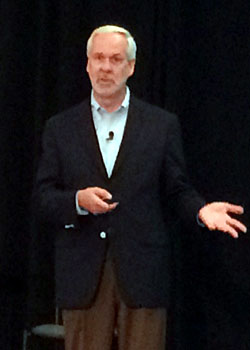Campus Tech 2015: Move Over, MOOCs
In May, Southern New Hampshire University conferred 318 nursing student degrees — a record for the nonprofit institution.
“The growth in nursing students can be attributed to a number of factors, including the increased demand driven by an aging population, as well as an older workforce with a significant number of Baby Boomers approaching retirement age,” a release from the university states. “In fact, the Bureau of Labor Statistics anticipates a 19.4 percent growth in nursing between now and 2022, with some 1.1 million jobs available nationwide by 2022.”

“Ten to 15 years ago, the problem was access. Now the problem is, how do we get more people to complete?” says Southern New Hampshire University President Paul LeBlanc.
That reality also directly influences a few of the university’s priorities, President Paul LeBlanc told those gathered Tuesday at the opening plenary keynote for Campus Technology 2015 in Boston. The first priority is meeting the needs of today’s modern students, who increasingly juggle competing demands for their time, attention and finances. Another priority is meeting the evolving needs of industry — and that means graduating students who are fully prepared to take on the challenges of today’s modern work environments and meet employers’ demands. U.S. higher education, generally, has not evolved quickly enough to meet those goals, LeBlanc said.
“The problem is going to loom larger: It’s a math problem. We know projections for retirement, we know what the workforce demands. We’re coming out of the recession of 2008, but we’re not producing enough graduates, and we’re not producing the kinds of graduates the workforce wants,” he said, citing recent data from the Pew Research Center. “Seventy-five percent of university provosts think graduates are ready for work on day one when they leave their institutions. Only 11 percent of employers think that’s the case.”
LeBlanc acknowledges that higher education’s mission should not be solely focused on the future employability of students, but he argues that higher education generally works to solves societal problems, and those problems frequently shift.
“Ten to 15 years ago, the problem was access. Now the problem is, how do we get more people to complete?” he said. “And it’s not enough to complete. We have to produce quality.”
Last week, LeBlanc shared similar sentiments during a U.S. Senate education committee meeting.
Technology-Backed Education
“One of the things I see in a lot of institutions when we talk about innovation is a shotgun approach: Everyone is talking about MOOCs, let’s do MOOCs,” LeBlanc said. “What problem did the University of Virginia Board of Trustees think they were solving by forcing [former university President Teresa A. Sullivan] to produce MOOCs?”
When higher education sets out to leverage new technology and tools as a means of fixing or reinventing itself, LeBlanc asked, which specific higher education is being fixed?
“One of the issues I have with our policy discussions: We talk about higher education for 18-year-olds, of people coming out of high school. In reality, there are many higher educations, and they all have their own problems and policy issues to solve.”
Higher education also includes military academies, research institutions, traditional liberal arts colleges, what he termed “big-time sports higher ed” and, increasingly, nontraditional higher education for adult learners — the list goes on. The problem nontraditional higher education should aim to solve is how to meet adult and nontraditional learners’ needs and help them prove competencies to current and future employers, LeBlanc said.
“How can we make [online offerings] equal to traditionally delivered courses? Actually, the best online courses are superior to traditionally delivered courses. … We have far better optics into the quality of teaching, of learning,” LeBlanc said.
Another critical question all institutions should continue to ask is how they are going to use technology to transform or meet their evolving missions. “As you drill down, there are thousands of strategic questions. Reading about really cool stuff and wanting to try it doesn’t solve problems. It’s not a good strategy.”
“Higher education business models have blown up. There’s real resistance to debt, resistance to rising costs, and that’s particularly true for nonselective, non-Ivy institutions,” he said.
“People ask how we’ve grown so fast. It’s because we are really, really good at customer service. That’s a phrase, by the way, that I can’t use on a traditional campus.”
“Online education is now widespread and much better. If MOOCs did nothing else, they legitimized online education,” LeBlanc said. “Today, 500 institutions are moving to competency-based education, and they are not-for-profit. There’s a lot of opportunity. There are new models of delivery, a lot of potential partners.”









